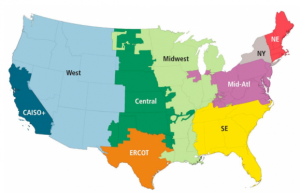November 2018 – Volume 20, Issue 8
In This Issue
Flanigan’s EcoLogic: CicLAvia
Energy Storage North America – 2018
Energy Storage 201
Using Wastewater to Grow Vegetables
Glow in the Dark Bike Paths
Upstream Responsibility: Walmart’s Gigaton Project
500 MW of Desert Solar Gets the Green Light
Travelogue: Millbrook and Oyster Bay

Flanigan’s EcoLogic: CicLAvia!
Ciclavia! A few weeks ago… the 27th time in Los Angeles. Part of a worldwide “open streets” phenomenon. There’s a clear consensus among tens of thousands of bicyclists to have a good time. Wholesome. I bike through Chinatown to meet Jonathan Parfrey – a founder of CicLAvia — and Gary Gero, now LA County’s Chief Sustainability Officer. We’re defiantly casual bikers… no lycra, Gary in flip flops.
This time, CicLAvia is a partnership event with LA Phil; the Philharmonic celebrating its 100th anniversary. So we begin on Grand Avenue in front of the Disney Concert Hall. It’s blazing hot where the sun reflects off the gorgeous and iconic concert hall. A huge stage is set, there are speeches, plaques. We meet as a high school band thunders at parade’s head, the sun shining brightly. This Sunday, CicLAvia opens an eight-mile route from the Disney Concert Hall to Capitol Records in Hollywood. We do the round trip.
Cyclovia – meaning bike path in Spanish – is a phenomenon that is now worldwide. It began in Bogata, Columbia, as a means of raising awareness of biking and walking in an auto-dominated city. The idea was to create an “open streets” festival. Streets are closed for autos… open instead to the public to bike, walk, and skate. Bogota does it weekly… so does Mexico City.
Today the sidewalks along the LA route are alive with vendors and music. The streets become public parks. CicLAvia has five times more people using its temporary park space during the event day than are using all of the other parks in the City of Los Angeles combined. There is music all along the route; seems like every two or three blocks there’s another act. Bars have bands out, so do schools. We pass an all-woman mariachi band… so much color! All along the route are tents and tables, discount coupons for LA Phil performances and such.
Since October 2010 when CicLAvia began in LA, about 1.5 million Los Angelenos have taken to the cordoned streets. CicLAvia is open to all forms of people-powered, non-motorized transport. It’s the biggest open streets event in the country. The routes vary. This time we’re riding past Museum Row, down Grand, then banging right on Wilshire, whooshing past MacArthur Park, before stints on Western and Highland. Our peddle-powered throng then takes Hollywood by storm. I like best passing marching bands.
Bikes of all descriptions; it’s congested. A wooden bicycle frame, laminated plywood, a proud rider knowing he’s got something “way cool.” We pass a bicycle towing a flatbed topped with a grand piano and pianist in full swing. A ten-foot long armadillo ambles by, its arms and legs in synchronized motion, powered by a bicyclist. There are many bicycles artfully fashioned into human powered insects on wheels. My Trek is so dull!
Mandatory Dismount areas for pit stops. All sorts of tents, information, water, and food trucks promoting their wares and services cause congestion and slow quick riders like us. The dismounts are too frequent… a necessary tactic and very small demerit of a hugely well-organized event. Safety is paramount. There must be hundreds if not thousands of volunteers out helping us cross streets safely, using oversized foam hands to signal eager bikers to a stop behind their ropes at traffic crossings. The LAPD presence is massive. And the event rolls without a hitch. Come join in; the next CicLAvia is December 2. You’ll be happy you did.
Energy Storage North America – 2018
 This past week I attended the Energy Storage North America conference. It was a testament to the dramatic rise of energy storage. Two thousand attendees from 30 countries, 150 speakers, and 100 exhibitors were on hand for one reason: Storage is essential for the transition to a renewably-powered society. While batteries are stealing the show, other storage technologies were on hand from phase-change materials, to thermal storage, compressed air, flywheels, and gravity-based storage systems.
This past week I attended the Energy Storage North America conference. It was a testament to the dramatic rise of energy storage. Two thousand attendees from 30 countries, 150 speakers, and 100 exhibitors were on hand for one reason: Storage is essential for the transition to a renewably-powered society. While batteries are stealing the show, other storage technologies were on hand from phase-change materials, to thermal storage, compressed air, flywheels, and gravity-based storage systems.
Janice Lin, Executive Director of the California Energy Storage Alliance (CESA) welcomed the group. She’s most welcoming and clearly proficient. She introduced Stella Li, President of BYD Motors, the world’s largest maker of electric vehicles, and later Penny McLean-Connor of Eversource, and Bill Gross, the founder and CEO of Idealab.
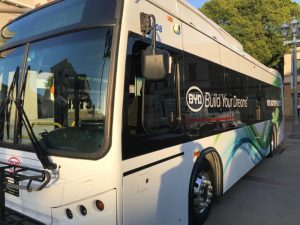 BYD – short for Build Your Dreams – began in 1995 as a Chinese battery manufacturer. Now it’s the largest battery maker in the world. Now BYD is a maker of EVs, electric trucks, buses, forklifts… even monorails known as “skyrails”. BYD sold 770,000 EVs last year… and Li reports that she just hired a Ferrari designer to make BYD cars more sexy! The company claims total solutions; it has a solar division and manufactures LED lamps. BYD is 10% owned by Berkshire Hathaway and brings in some $20 billion in annual revenues.
BYD – short for Build Your Dreams – began in 1995 as a Chinese battery manufacturer. Now it’s the largest battery maker in the world. Now BYD is a maker of EVs, electric trucks, buses, forklifts… even monorails known as “skyrails”. BYD sold 770,000 EVs last year… and Li reports that she just hired a Ferrari designer to make BYD cars more sexy! The company claims total solutions; it has a solar division and manufactures LED lamps. BYD is 10% owned by Berkshire Hathaway and brings in some $20 billion in annual revenues.
Li’s most important message was that repurposed batteries from buses will easily provide the storage capacity required to enable a 100% renewable future. China has a goal for all buses nationwide to be electric – more than 805,00 buses – by 2025. That’s 240 GWh of battery capacity. After tours of duty in buses, batteries still have plenty of storage capacity to be repurposed for stationary installations. So far, BYD has manufactured 45,000 buses, with 13.5 GWh of battery power. Now BYD is manufacturing buses with 6 GWh of battery capacity each year and each bus will be retired after 8 years. Shortly, 4 GWh of batteries will be retired each year. Compare that to California’s goal of 1.6 GW of storage. Li sees achieving this goal as “no big deal”.
Li tells the story of her introduction to ebus sales: Everyone said that ebuses were terrible in 2011. (Can’t go up hills, severely limited range, etc.) She offered to loan buses to prestigious customers, free trials. Her first taker was Stanford University. The three buses it tried… it still operates! Then in 2016 Antelope Valley was the first bus system to announce its plans for full electrification. Starting next year, both San Francisco and Los Angeles will only buy electric to replace retiring buses… both with goals for 100% ebuses.
The keynotes then shifted to utility innovation. Eversource Energy is New England’s largest electric utility. It serves four states and is innovating to meet state goals. Massachusetts, for example, intends to decrease greenhouse gas emissions by 80% by 2050; it has a 1,000 MWh storage mandate; plus a goal to have 300,000 EVs on the road by 2025.
Penny McLean-Connor explains that Eversource is working to achieve these goals in a number of ways. For storage, it’s a multi-pronged solution including both “front-of-the-meter” storage (utility scale) and “behind-the-meter,” storage on the customer side of the meter… “where you engage customers,” said McLean-Connor. Eversource is also looking at thermal storage in the form of ice systems. A pilot program involved phase-change materials (another form of storage using saline solutions) at the Boston Food Bank. The phase change materials there allow for zero power use during peak periods.
Eversource is focusing storage solutions in areas where the grid is most vulnerable… like on Cape Cod. There a single feeder line is vulnerable to storms and failure. It is now backed up with utility-scale storage built into and obscured within a classic New England, shingled barn. Eversource is using storage to cost-effectively support its worst-performing circuits. It’s working on a microgrid project on Martha’s Vineyard too.
Eversource is also promoting EV car sharing, purposefully delivering mobility to lower income customers by socializing the cost of infrastructure. Rather than relying on individual car owners to install chargers at their own cost, Eversource is ratebasing EV charging… installing $45 million worth of chargers to adapt to a radically changing utility landscape that now will incorporate heightened levels of electric mobility.
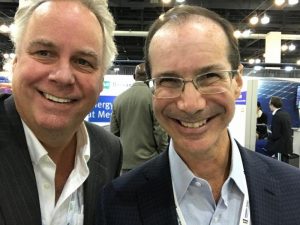
Ted and Bill Gross
Bill Gross is the Founder and CEO of Idealab in Pasadena. He modeled the labs after the Edison Labs in New Jersey which spun off the phonograph, movie projectors, light bulbs… and ultimately Edison Light Companies.
A self-professed parallel entrepreneur, versus serial entrepreneur, he has helped to incubate 150 companies. Gross talked about how entrepreneurs most often have to cross through the dark swamp of despair… success marked by one’s ability “to power through that phase.” Wherever you are innovating, you have to buck the consensus, and prove that your new idea works.
Gross stressed that, “This is the moment for storage.” Storage will be as transformative to society as plastics. His presentation supported his theme that renewables have created a tipping point for storage… potentially three of them!
By 2010, we had passed the first tipping point. Renewable energy had reached a sustained investment level of $300 billion per year. Solar had dropped from $78/watt to 39 cents a watt. Currently, the cost of renewable power is less than the cost of anything else, new that is. With global power growth at 2.5% annually, virtually all new capacity will be renewable. But what about the other 97.5%?
Gross explains that the second tipping point will come about when the cost of renewables is cheaper than existing power plants. But, he explained with a sparkle in his eye… there is one problem: The sun only shines for six hours a day.
To achieve the third tipping point, we need storage. “We need every method in the book to do this.” At that time, when the cost of renewables plus storage is less than the cost of existing capacity… then the flood gate will open. When you can buy solar for 1.9 cents per kWh, and storage for 2.9, for a total of 4.8 cents… then the market will explode as solar + storage is cheaper than buying from the grid.

Energy Vault’s Gravity Storage
Gross then told the forum about his major pursuit of highly cost-effective storage, far less than the cost of batteries and chemical storage. Pumped storage is the most cost-effective form of storage and represents 96% of storage in America today. But all the good sites are developed. So Gross created a lift on a ski slope to raise gravel up a mountain, and to then release it at peak periods. This scheme suffered from 70% round-trip efficiency, and he quipped that you still need a mountain! He then engineered and built a pumped storage silo, which modeled storage at a cost of $945 kWh, given the cost of concrete. He tried drilling into the ground, at a cost of $719. Then he worked with steel cylinders $561, then tapered steel $443, then used concrete baffles, all driving down the cost of storage.
Finally, he came across the notion of lifting concrete blocks with cranes. Massive cranes will raise and stack concrete blocks into a tower, and then will lower the blocks to generate power during peak periods. This 90+% efficient “gravity storage system,” is more efficient than pumped storage is now being developed by Energy Vault. Recently, Tata Energy contracted with Energy Vault for a 35 MWh installation.
Energy Storage 201
The day before the opening of the ESNA conference, I attended Energy Storage 201… an in-depth workshop and review of the state of storage in seven regions of America. These are the seven Independent System Operators (ISOs) that manage the national power grids. In California, the California ISO manages and dispatches 1,400 power plants throughout the state. Soon these ISOs will likely be dispatching storage capacity and energy as well. Inversely, access to these markets will allow storage devices cash revenues for the sale of services that have not had market value thus far.
The workshop was expertly presented by Customized Energy Solutions (CES). Fully 96% of the energy storage capacity in the country is pumped storage. Then there’s about 800 MW of Advanced Energy Storage (AES) in America, all forms of storage except pumped storage hydro.
Each ISO is having to develop processes to address storage to provide not only customer benefits (resilience, peak shaving, energy arbitrage) at the retail level, but also grid support services at the wholesale level. This involves ancillary services such as frequency control up and down, ramping services, spinning reserve, non-spinning reserve, black start, and reactive supply.
FERC regulates America’s wholesale power market through its interaction with the seven ISOs that cover 2/3 of America. Six of these are under FERC control; the Texas ISO, ERCOT, is not. For some time, FERC has been friendly to advanced storage with Orders 890, 755, 784, 792, 841, 842, and 845. FERC has been supportive of leveling the playing field and providing clearer rules and access to the market.Order 890 codified no discrimination on transmission lines; FERC Order 755 provided clearer AES compensation rules; 841 was “landmark…” making clear that AES is not just for frequency regulation but is applicable to any market product. FERC Order 841 requires compliance filings December 2018, and full-scale implementation by December 2019.
So storage is on a rapid rise, and issues remain: Which products can be sold to market? What are the minimum capacity contributions? What length of discharge is required? How can the ISOs integrate “non-continuous resources” into the market, resources that provide for dual participation in retail and wholesale markets? What values ought to be assigned to “mileage rates,” the speed at which AES resource can “ramp up” or “ramp down?”
CEM professionals reviewed the ISOs’s positions on storage: The Pennsylvania-Jersey-Maryland (PJM) ISO is the largest wholesale market in the country encompassing 13 states, 64 million people, and a peak demand of 165 GW, three times that of California. It got an early start with AES and has 300 GW installed. While PJM requires only 100 kW of AES capacity to access the wholesale services market (enabling the sale of ancillary services), PJM rules require a 10-hour discharge capability, a vestige of the region’s pumped storage experience.
California is now reportedly “way ahead” of the national market. California has its own ISO. Recent legislation in the Golden State is focused on streamlining interconnection of storage. New York also has its own ISO. New York is made up of very different zones, the power system there marked by unique downstate power bottlenecks. The New England ISO covers six states and 14.8 million people. Since New England is at the end of natural gas pipelines, it has the highest prices in nation for power… making storage all the more viable there.
Using Wastewater to Grow Vegetables
 Ok, hang on. This is worse than eating bugs! Researchers at Georgia Tech have been awarded a $5 million grant to grow vegetables in wastewater. Sound appetizing?
Ok, hang on. This is worse than eating bugs! Researchers at Georgia Tech have been awarded a $5 million grant to grow vegetables in wastewater. Sound appetizing?
Now be rational: Today our sewage treatment plants expend tremendous energy and costs removing organic material from wastewater. On the other hand, farmers have to fertilize with tremendous amounts of costly organic fertilizers. By farming using wastewater, both objectives are met. OK? “Currently we treat wastewater by taking all the nutrients from it,” said researcher/professor Yongshen Chen, “Then we have to use an energy-intensive process to synthesize and add fertilizer to the food production process.”
The system uses an anaerobic membrane biological treatment process that transfers organic contaminants into biogas and remove pathogens such as E Coli to ensure food safety. The smart membrane system – nanomaterials – to extract trace contaminants like endocrine disruptors, heavy metals, and pharmaceuticals… nutrients that are left are pumped into the hydroponic system. USDA grant/award, five years.. Let’s hit some acronyms… this is a DWW-CEAs… Domestic WasteWater, Controlled Environment Agriculture system!
In related news, the Gates Foundation has invested over $200 million dollars in a mission to reimagine “the humble toilet,” to make bold gains in the future of sanitation. Bill Gates is so into it: Imagine the world’s richest man walking on stage to give a talk with a jar of poop at this side. That happened not long ago in China at the Reinvented Toilets Expo in China.
“It’s been done this way for centuries,” noted Gates. But more than 4.5 billion people do not have access to toilets where waste is treated and disposed of safely. In many instances, pathogens from waste seep into the environment causing diseases. So in 2011 the Gates Foundation launched the Reinvent the Toilet Challenge. At the recent Reinvent Toilet Expo in China, 20 exhibitors presented new toilet solutions. Some reinvented toilets look the same, but instead of being connected to a sewage system that flushes wastewater far away, everything is processed internally. Another solution, the Nano Membrane Toilet, was developed by researchers at Cranfield University in the U.K. and works without water or a power source.
Glow in the Dark Bike Paths
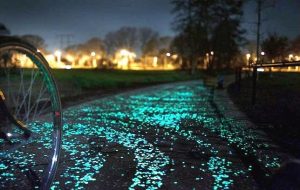
the Van Gogh-Roosegaarde lit cycle path.
Credit@ Studio Roosegaarde via Flickr.com
Glow in the dark bike paths are well beyond concept stage and may provide tremendous utility at night when walkers and bikers share the road. Starpath was built in 2013 at Christ Pieces Park and covers 1,614 square feet of path with a spray-on, glow-in-the-dark coating.
Not much later in 2014, Dutch designer, Dan Roosegaarde created the “Starry Night” bike trail in the town of Eindoven where Van Gogh lived for few years. The path glows in the dark; using the same technology as the photoluminescent stars we put on our ceilings as kids. Remember the stars and moons that glowed in the dark long after lights out? The Van Gogh Path absorbs light during the day and releases it at night. Developers call it “techno-poetry… a function of extraordinary thinking, humor, design talent, and engineering brilliance.”
Daan Roosegaarde, the path’s inventor also developed a light show that uses car headlights and reflectors inspired by the reflections of light on butterfly wings. He’s also invented a bike that cleans the air while you ride, inhaling dirty air, filtering it, and releasing clean air around the cyclist. Its smog-eating tower has an electrostatic precipitator where particles are ionized and attracted to a charge screen. Roosegaarde collects the dirt and turns it into jewelry.
Now Poland is kicking the concept of a traditional bike trail to the curb. Charged by sunlight during the day, in 2016 the rural town of Lidzbark Warminski opened a short bike path that glows in the dark. The asphalt contains synthetic particles called “luminophores” which at night emit power captured by sunlight, creating an electric blue hue. The glow reportedly lasts up to 10 hours. The goal of the 328-foot long test is to prevent bike/pedestrian accidents at night.
Upstream Responsibility: Walmart’s Gigaton Project
 Walmart’s Gigaton Project was launched in April 2017 to partner with its supply chain suppliers to collectively reduce their GHG emissions by a gigaton. That’s the equivalent of taking 211 million cars off the road. Project Gigaton provides a toolkit for Walmart’s broad network of suppliers, a means of partnering to reduce Scope 1, 2 and 3 greenhouse gas emissions by a gigaton by 2030. Walmart has identified agriculture, waste, packaging, deforestation, and product use and design as the goal areas in which to focus Scope 3 efforts.
Walmart’s Gigaton Project was launched in April 2017 to partner with its supply chain suppliers to collectively reduce their GHG emissions by a gigaton. That’s the equivalent of taking 211 million cars off the road. Project Gigaton provides a toolkit for Walmart’s broad network of suppliers, a means of partnering to reduce Scope 1, 2 and 3 greenhouse gas emissions by a gigaton by 2030. Walmart has identified agriculture, waste, packaging, deforestation, and product use and design as the goal areas in which to focus Scope 3 efforts.
Walmart itself is committed to reducing its own Scope 1 and Scope 2 GHGs by 18% by 2025. In 2017, Walmart was getting 25% of its electricity from renewable sources. Now the count is 28%. The company’s goal for renewables is 50% by 2025. The company has pledged to continue to boost onsite renewables. Walmart has 11,695 stores in 28 countries. Currently there are 270 Walmart sites with onsite solar. Now Walmart will add solar systems to 130 more by 2020. The company also doubled the efficiency of its truck fleet between 2005 and 2015.
By April 2018, Walmart suppliers had reduced emissions by 20 million metric tons… 5% of the Gigaton goal by 2030. Most of the savings to date have come from greening electricity use.
One highlighted participant is Proctor and Gamble (P&G), the maker of Tide laundry detergent. Thanks to the Gigaton Project, P&G will encourage its customers to join the Tide #QuickColdPledge, switching to quick and cold laundry cycles that use less energy and create 40% fewer emissions on each and every load.
The Gigaton Project has also expanded into China this year. Another announcement in April from Walmart’s Milestone Summit, is that Walmart will double its EV charging stations for customers’ convenience, including some super-fast units that can charge an EV in ~30 minutes.
500 MW of Desert Solar Gets the Green Light
 After a decade of legal battles, the $1 billion, 500 MW Palen Solar Project has finally won federal approval from the U.S. Bureau of Land Management. The BLM manages more than 245 million acres of public land primarily in 12 western states. The Palen site is located in Riverside County in a Solar Energy Zone and Development Focus Area slated for utility-scale solar development.
After a decade of legal battles, the $1 billion, 500 MW Palen Solar Project has finally won federal approval from the U.S. Bureau of Land Management. The BLM manages more than 245 million acres of public land primarily in 12 western states. The Palen site is located in Riverside County in a Solar Energy Zone and Development Focus Area slated for utility-scale solar development.
Instead of building a solar thermal plant with 750-foot tall solar receiving towers as originally planned, the new project owner, EDF Renewables, will develop a 3,140-acre sea of photovoltaic panels with less visual and water-use impact. EDF projects a 30-month construction period including the construction of a seven-mile, 230 kV transmission line to connect with the Southern California Edison grid.
Travelogue: Millbrook and Oyster Bay
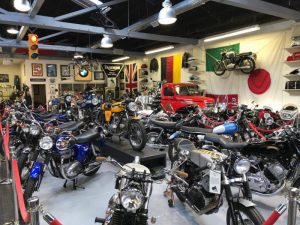
Billy Joel Museum
Jet Blue from LAX to JFK. Love flying and meeting people! Talked with seat mate Lara from LA well past Iowa. Fascinating story she tells: Born and raised in Saudi Arabia where her parents worked for ARAMCO. She regaled me with stories of the gated compounds of ex pats of her youth. Then prep school in New Jersey before college and law school at University of Southern California. Now raising a family in west LA. We shared pasts and values and the time passed quickly. We had to stop to prep for respective East Coast works.
JFK in the afternoon. Gotta love it! Air Tran to Federal Circle, Alamo, then the Belt to the Southern State Parkways. Jams. Things open on up on the Seaford/Oyster Bay. Got to our family place on Yellowcote Road and to Mom’s house by 5:00, well in time for a fresh air walk. Gorgeous weather, late afternoon sun, trees turning… jets circling on landing patterns are a reminder of the sprawling metropolis so close by. Everything is vivid in color, the greens of grasses and trees, the blue skies with billowing clouds… all so clean and lush and appealing. Dinner in the kitchen, just as my mother loves it.
Picked up brother Russell at JFK the next morning. He flew down from Burlington at the crack of dawn. I scoop him up across the street from the old TWA terminal that I so fondly remember when new, its renovation and new hotel facilities appear nearly done. We then took the Van Wyck to the Whitestone Bridge, to the Hutchison, Cross County, Sprain, and Taconic Parkways, catching up on family and getting ready for the site visit at Millbrook School.
At Millbrook, EcoMotion is working on a number of fronts… solar performance, the school’s outstanding efficiency potential, some tricky dorm retrofits, options for solar enhancement, and ongoing climate planning. We met with the school’s extraordinarily talented facilities director and are briefed on the new digital controls that have replaced failing pneumatics in the gym. We meet with the School’s new Chief Operating Officer, and later the School’s new Sustainability Steward whose energy and sincerity is palpable.
Since EcoMotion helped develop the solar field there, power use on campus has surged given more students, more facilities, increased operations in general. We delivered our 2018 Energy Efficiency Assessment. It details 98 efficiency measures on campus with multiple benefits… from noise abatement, to greater HVAC control, comfort, energy savings, and environmental benefits. We know that it’s hard to package efficiency in a sexy way that gets attention… and that gets funded or financed. The assessment informs the Board. It’s time to define next steps in carbon neutrality… ones that are indeed cost effective and that provide co-benefits.
We hit downtown Millbrook for an early dinner with Jane and Jono. They’re my dear friends and recently retired from the school. Jono ran Millbrook School’s zoo for 42 years! Jane headed up Environmental Studies and spearheaded the solar project, starting with bringing in EcoMotion. We’re joined for a drink by Alison, one-third of the triumvirate of my freshman biology and zoology study group. (We’re still in touch with the third, now a professor at Cornell.) Alison lives in Millbrook and promotes poets and was celebrating her birthday.
I chaperone Mom to church and afterwards catch up with Brian, my friend and grade school hockey defense partner. He’s in the semiconductor business. Brothers of sorts, we snap a selfie. Later and in prep for an evening lecture and film screening, I read a hundred pages of the “Millionaire’s Unit,” the story of a group of Yalies just before America’s forced entry into World War 1 who were determined to form an air unit to protect America’s coastline.
The book is a detailed account of extraordinary leadership, these rich students taking to the skies at the onset of sophisticated aviation, just a dozen years after the Wright Brothers famous flights. This was beyond the call of duty and extremely dangerous. But these young men felt that they owed it to society – even in the face of Navy Department dismissal of their offer to form an aviation unit to patrol the Atlantic seaboard. They persevered, forming the First Yale Unit, a precursor to the U.S. Airforce.
The lecture is by Harry Davison, grandson of Trubee Davison who catalyzed the Millionaire’s Unit. He’s proud and knowledgeable and a terrific presenter. The film that he produced – including newly filmed dogfights shot in New Zealand — is a powerful documentary with exciting footage. We dine and are heartened and impressed by the Yalies’ determination and grit – what they called “sand.”
My cousin John is in the music business, producing music for TV shows. Among other duties, he’s composed music for the television production of the New York City Marathon. He works downtown at IMG, but it’s Sunday and he asks me to check out a Mick Rock a pop-up photography exhibition in Plainview with him. The famed photographer is there, his works of the Stones, Bon Jovi, Madonna, and others are great to see. Our windshield time is for catching up. We double back to Oyster Bay to check out a new psychedelic art gallery there, followed by a visit to Billy Joel’s motorcycle museum.
Billy Joel began his career in Oyster Bay, playing at Uwe’s Old Homestead, just three doors down from Nobman’s Hardware store where I worked through high school. The Piano Man is his story and his identity. My brother Billy and I saw him play in 1973… just as he was breaking out nationally. Peter Tosh opened for him. Recently, Billy Joel toured with sir Elton John.
Billy Joel is a local legend. His motorcycle museum that we visit is a huge space full of bikes he’s collected. “Let me know if you have any questions. Nothing’s for sale,” says a voice from the back of the room. Later John chats with the man. He’s Billy’s fulltime motorcycle mechanic; Billy had been by earlier that day on a bike. This is his town, his life! He supports local issues like the bay’s ecology … while periodically helicoptering from his Center Island home to Madison Square Garden to play for sold-out crowds.

